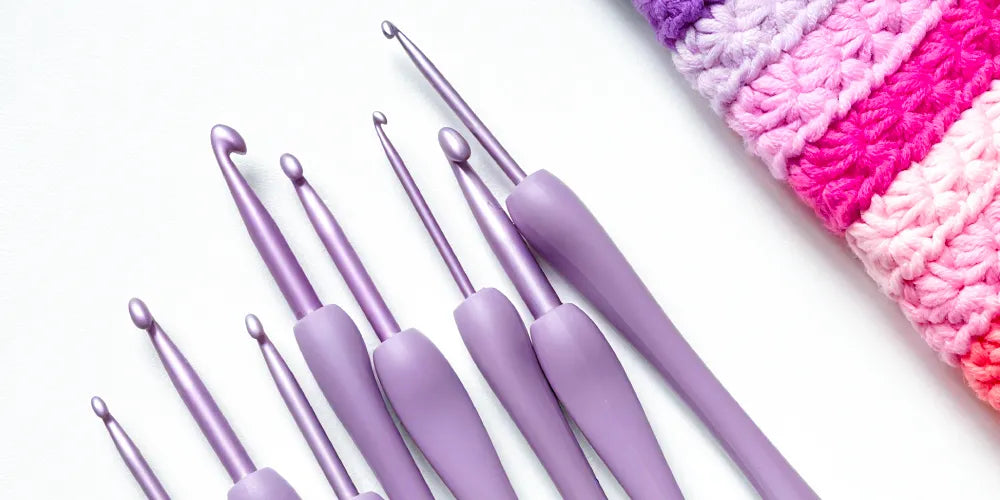
Mastering Crochet Hooks: Sizes, Types, and Expert Picks
Share
Crocheting is as much about the tools as it is about the craft. Selecting the right crochet hook can elevate your stitching experience—or hinder it entirely. The right hook doesn’t just glide through yarn; it helps maintain consistency, rhythm, and comfort. Let’s dive into the essential elements of crochet hooks, how to choose them wisely, and which options are worth adding to your toolkit.
Anatomy of a Crochet Hook
-
Head / Point
Typically conical or straight-edged, this is the part that enters each stitch—precision matters here. -
Throat
Shaped either inline or tapered, it’s the section where the yarn gets caught. Think of it as the hook’s dynamic workspace. -
Shaft
This is the portion stretching from throat to grip, and its diameter determines both hook size and stitch size. It serves as your stitch’s holding chamber. -
Grip
The part your fingers rest on. Manufacturers fine-tune materials and width to create a snug, fatigue-reducing hold. -
Handle
Found at the opposite end of the head, it helps balance the tool in your hand.
Shaft, grip, and handle design often define ergonomic crochet hooks, where user comfort is prioritized for long-haul stitching sessions.
Types of Hook Shapes
-
Inline
A sharply defined throat with a pointed head that aligns cleanly with the shaft. Ideal for evenly sized stitches and control. -
Tapered
Features a rounded head and gently sloped throat, offering smoother, more intuitive movement.
Crochet Hook Materials
-
Aluminum
Lightweight, tough, and silky smooth through yarn—great for beginners. Brands like Boye and Susan Bates lead in this category. -
Plastic
Extremely lightweight and low-cost. Often used for oversized hooks. However, durability may be a drawback. -
Wood
Warm in hand and offers natural grip due to slight friction—great for slippery yarns. Popular with crafters seeking an organic feel. -
Steel
Ultra-fine hooks designed for lace or thread work. These resemble needles and are not ideal for novices. -
Ergonomic Hooks
Designed with soft, oversized grips to reduce hand strain. Favorites include Clover Amour and Prym Ergonomics. -
Tunisian (Afghan) Hooks
Long, straight or flexible hooks that hold multiple stitches, used for hybrid crochet-knit techniques.
Understanding Crochet Hook Sizes
Hook size is defined by the shaft diameter, which determines stitch width. Sizing systems vary by region:
-
US System
Combines letters and numbers. -
Metric System
Measures the shaft in millimeters.
Hook Size and Yarn Weight Chart:
| Metric | US | Yarn Weight |
|---|---|---|
| 2.25mm | B/1 | Lace (0), Fine (1–2) |
| 3.5mm | E/4 | Light (3) |
| 5mm | H/8 | Medium (4) |
| 6.5mm | K/10.5 | Bulky (5–6) |
| 10mm | N/15 | Jumbo (7) |
How to Match Yarn with Hook Size
While not every yarn requires a strict hook pairing, improper combinations can result in loose, saggy stitches or tight, rigid ones. Control your tension by:
-
Reading Yarn Labels
Most provide a suggested hook size. However, you can deviate based on design intent. For instance, use a larger hook for airy drape in blankets. -
Following Patterns
Patterns typically specify hook and yarn pairings. If unclear, consider contacting the pattern’s creator. -
Using a Gauge Swatch
Crochet a 4x4 inch sample using the recommended hook. Compare it to the pattern’s gauge. Adjust hook size as needed for alignment. -
Measuring Hook Size Without Labels
Use a hook gauge tool—insert the shaft into different-sized holes until you find a snug fit.
Final Thought
Your crochet journey will evolve—so will your hook preferences. Start with the essentials. As your skills grow, so will your understanding of grip, material, and hook behavior. Let comfort guide your hand, and let quality fuel your creativity.

